INTERNETWORKING.
VerifiedAdded on 2023/01/23
|8
|1765
|94
AI Summary
Contribute Materials
Your contribution can guide someone’s learning journey. Share your
documents today.

Running head: INTERNETWORKING
Internetworking
Name of the Student
Name of the University
Author Note
Internetworking
Name of the Student
Name of the University
Author Note
Secure Best Marks with AI Grader
Need help grading? Try our AI Grader for instant feedback on your assignments.

Table of Contents
Scope of the Project:..................................................................................................2
Challenges:................................................................................................................. 2
User Centric Design Concept:....................................................................................2
Hardware Requirements:............................................................................................3
Cables:.................................................................................................................... 3
Servers:...................................................................................................................4
Hosts:...................................................................................................................... 4
Network Design:.........................................................................................................5
Justification:................................................................................................................5
Outcomes:.................................................................................................................. 5
Limitations:.................................................................................................................5
Conclusion:.................................................................................................................6
References:................................................................................................................ 7
Scope of the Project:..................................................................................................2
Challenges:................................................................................................................. 2
User Centric Design Concept:....................................................................................2
Hardware Requirements:............................................................................................3
Cables:.................................................................................................................... 3
Servers:...................................................................................................................4
Hosts:...................................................................................................................... 4
Network Design:.........................................................................................................5
Justification:................................................................................................................5
Outcomes:.................................................................................................................. 5
Limitations:.................................................................................................................5
Conclusion:.................................................................................................................6
References:................................................................................................................ 7
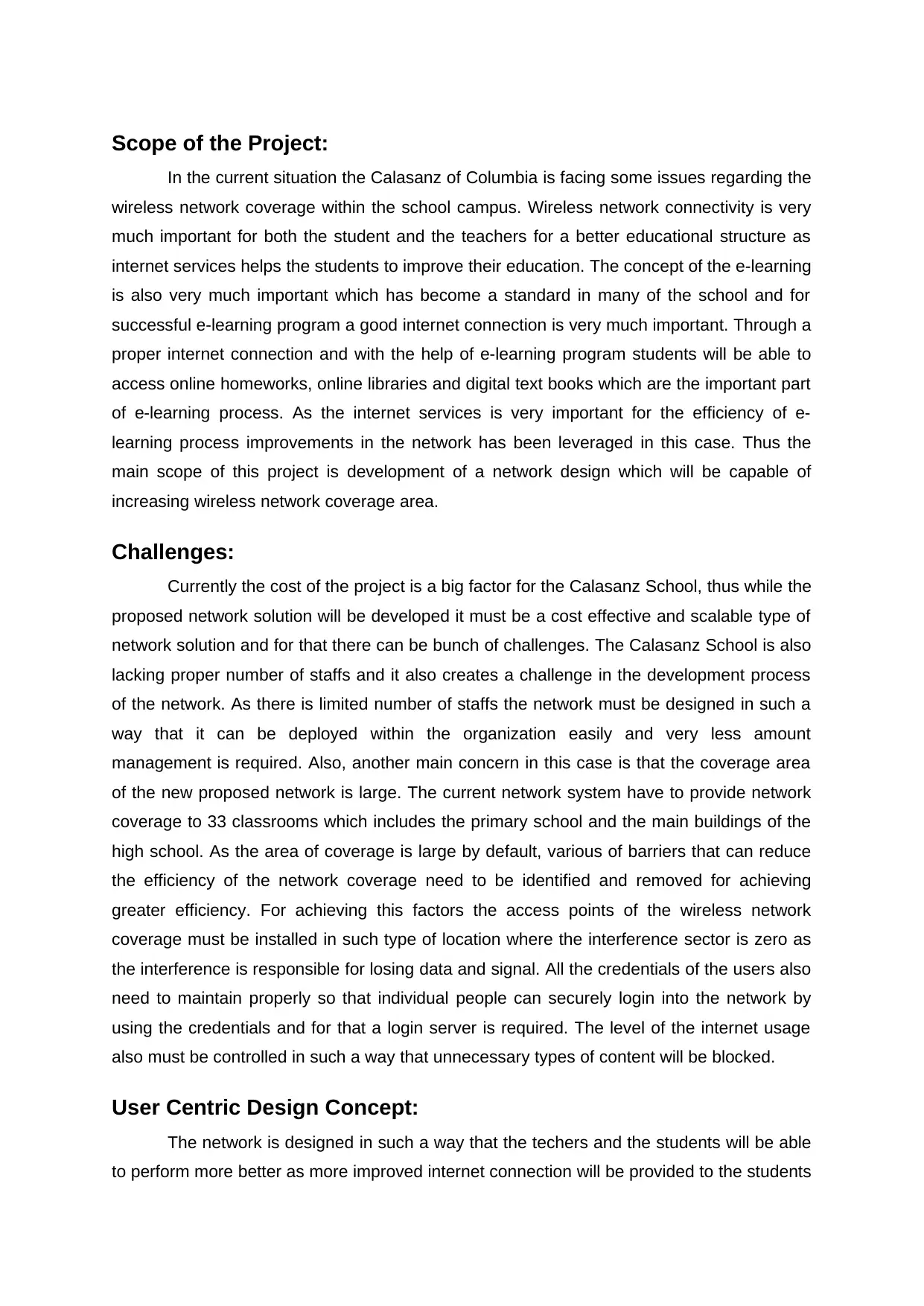
Scope of the Project:
In the current situation the Calasanz of Columbia is facing some issues regarding the
wireless network coverage within the school campus. Wireless network connectivity is very
much important for both the student and the teachers for a better educational structure as
internet services helps the students to improve their education. The concept of the e-learning
is also very much important which has become a standard in many of the school and for
successful e-learning program a good internet connection is very much important. Through a
proper internet connection and with the help of e-learning program students will be able to
access online homeworks, online libraries and digital text books which are the important part
of e-learning process. As the internet services is very important for the efficiency of e-
learning process improvements in the network has been leveraged in this case. Thus the
main scope of this project is development of a network design which will be capable of
increasing wireless network coverage area.
Challenges:
Currently the cost of the project is a big factor for the Calasanz School, thus while the
proposed network solution will be developed it must be a cost effective and scalable type of
network solution and for that there can be bunch of challenges. The Calasanz School is also
lacking proper number of staffs and it also creates a challenge in the development process
of the network. As there is limited number of staffs the network must be designed in such a
way that it can be deployed within the organization easily and very less amount
management is required. Also, another main concern in this case is that the coverage area
of the new proposed network is large. The current network system have to provide network
coverage to 33 classrooms which includes the primary school and the main buildings of the
high school. As the area of coverage is large by default, various of barriers that can reduce
the efficiency of the network coverage need to be identified and removed for achieving
greater efficiency. For achieving this factors the access points of the wireless network
coverage must be installed in such type of location where the interference sector is zero as
the interference is responsible for losing data and signal. All the credentials of the users also
need to maintain properly so that individual people can securely login into the network by
using the credentials and for that a login server is required. The level of the internet usage
also must be controlled in such a way that unnecessary types of content will be blocked.
User Centric Design Concept:
The network is designed in such a way that the techers and the students will be able
to perform more better as more improved internet connection will be provided to the students
In the current situation the Calasanz of Columbia is facing some issues regarding the
wireless network coverage within the school campus. Wireless network connectivity is very
much important for both the student and the teachers for a better educational structure as
internet services helps the students to improve their education. The concept of the e-learning
is also very much important which has become a standard in many of the school and for
successful e-learning program a good internet connection is very much important. Through a
proper internet connection and with the help of e-learning program students will be able to
access online homeworks, online libraries and digital text books which are the important part
of e-learning process. As the internet services is very important for the efficiency of e-
learning process improvements in the network has been leveraged in this case. Thus the
main scope of this project is development of a network design which will be capable of
increasing wireless network coverage area.
Challenges:
Currently the cost of the project is a big factor for the Calasanz School, thus while the
proposed network solution will be developed it must be a cost effective and scalable type of
network solution and for that there can be bunch of challenges. The Calasanz School is also
lacking proper number of staffs and it also creates a challenge in the development process
of the network. As there is limited number of staffs the network must be designed in such a
way that it can be deployed within the organization easily and very less amount
management is required. Also, another main concern in this case is that the coverage area
of the new proposed network is large. The current network system have to provide network
coverage to 33 classrooms which includes the primary school and the main buildings of the
high school. As the area of coverage is large by default, various of barriers that can reduce
the efficiency of the network coverage need to be identified and removed for achieving
greater efficiency. For achieving this factors the access points of the wireless network
coverage must be installed in such type of location where the interference sector is zero as
the interference is responsible for losing data and signal. All the credentials of the users also
need to maintain properly so that individual people can securely login into the network by
using the credentials and for that a login server is required. The level of the internet usage
also must be controlled in such a way that unnecessary types of content will be blocked.
User Centric Design Concept:
The network is designed in such a way that the techers and the students will be able
to perform more better as more improved internet connection will be provided to the students

both inside and the outside of the classroom. The designed network can be easily accessed
and managed by a central location which makes it very much easy for the IT team to handle
this network system. This design also makes it futureproof for upgradation in future. The
overall network is divided into many subnets which aims to reduce the collision, congestion
and loss of data packets within the network. The multiple subnets are configured with many
VLAN and a proper name has been given to each of subnets. For the wireless access
points, this is configured with the SSID so that each of the user can connect respect to their
department only. Access policy is also utilised and it defines that user will be not be able to
access sensitive information about the school in an unauthorised manner.
Hardware Requirements:
For successful completion of the project some hardware are required which are listed
below.
Device Description Model Series Specification
TP-Link Celling
Mount AP
CAP1750 Auranet Cap Series 2.4 and 5 GHz,
Multiple SSIDs and
WDS
TP-Link Gigabit
Load Balance
Broadband Router
TL-ER5120 Load Balance Series 64 bit with dedicated
dual core processor
TP-Link Managed
Switches
T2600G-18TS JetStream Series Switching Capacity:
36 GBPS and
Packet forwarding
rate: 26.78 Mbps.
Cables:
Cables are essential for connecting the hardware with each other. The two types of
cables which are required in this case are:
Distribution Cable:
Cable Name: CAT 6
Maximum Speed Capability: 10 GBPS
Ethernet Name: 10G Base –T
Cable Distance: 100m
and managed by a central location which makes it very much easy for the IT team to handle
this network system. This design also makes it futureproof for upgradation in future. The
overall network is divided into many subnets which aims to reduce the collision, congestion
and loss of data packets within the network. The multiple subnets are configured with many
VLAN and a proper name has been given to each of subnets. For the wireless access
points, this is configured with the SSID so that each of the user can connect respect to their
department only. Access policy is also utilised and it defines that user will be not be able to
access sensitive information about the school in an unauthorised manner.
Hardware Requirements:
For successful completion of the project some hardware are required which are listed
below.
Device Description Model Series Specification
TP-Link Celling
Mount AP
CAP1750 Auranet Cap Series 2.4 and 5 GHz,
Multiple SSIDs and
WDS
TP-Link Gigabit
Load Balance
Broadband Router
TL-ER5120 Load Balance Series 64 bit with dedicated
dual core processor
TP-Link Managed
Switches
T2600G-18TS JetStream Series Switching Capacity:
36 GBPS and
Packet forwarding
rate: 26.78 Mbps.
Cables:
Cables are essential for connecting the hardware with each other. The two types of
cables which are required in this case are:
Distribution Cable:
Cable Name: CAT 6
Maximum Speed Capability: 10 GBPS
Ethernet Name: 10G Base –T
Cable Distance: 100m
Secure Best Marks with AI Grader
Need help grading? Try our AI Grader for instant feedback on your assignments.
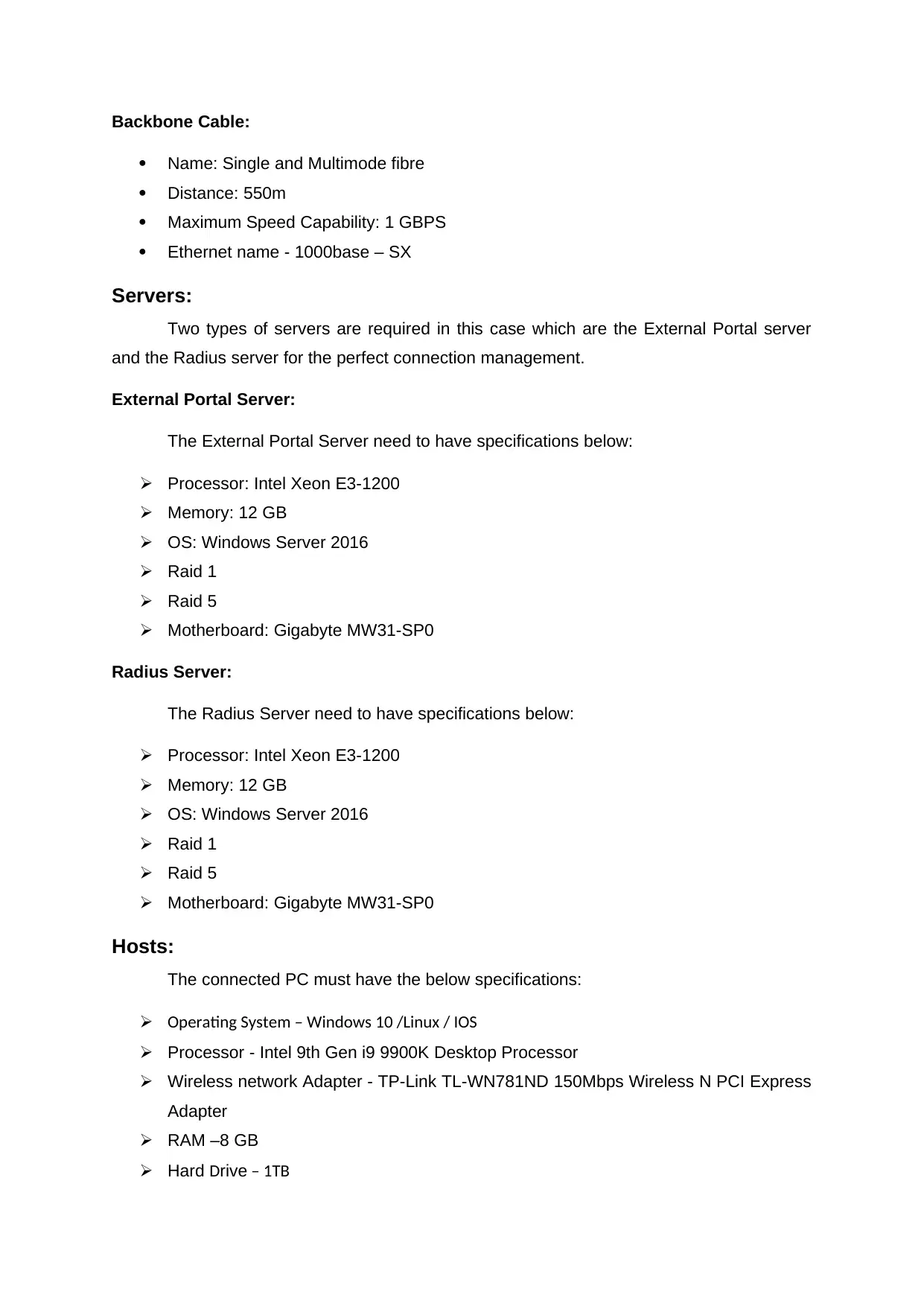
Backbone Cable:
Name: Single and Multimode fibre
Distance: 550m
Maximum Speed Capability: 1 GBPS
Ethernet name - 1000base – SX
Servers:
Two types of servers are required in this case which are the External Portal server
and the Radius server for the perfect connection management.
External Portal Server:
The External Portal Server need to have specifications below:
Processor: Intel Xeon E3-1200
Memory: 12 GB
OS: Windows Server 2016
Raid 1
Raid 5
Motherboard: Gigabyte MW31-SP0
Radius Server:
The Radius Server need to have specifications below:
Processor: Intel Xeon E3-1200
Memory: 12 GB
OS: Windows Server 2016
Raid 1
Raid 5
Motherboard: Gigabyte MW31-SP0
Hosts:
The connected PC must have the below specifications:
Operating System – Windows 10 /Linux / IOS
Processor - Intel 9th Gen i9 9900K Desktop Processor
Wireless network Adapter - TP-Link TL-WN781ND 150Mbps Wireless N PCI Express
Adapter
RAM –8 GB
Hard Drive – 1TB
Name: Single and Multimode fibre
Distance: 550m
Maximum Speed Capability: 1 GBPS
Ethernet name - 1000base – SX
Servers:
Two types of servers are required in this case which are the External Portal server
and the Radius server for the perfect connection management.
External Portal Server:
The External Portal Server need to have specifications below:
Processor: Intel Xeon E3-1200
Memory: 12 GB
OS: Windows Server 2016
Raid 1
Raid 5
Motherboard: Gigabyte MW31-SP0
Radius Server:
The Radius Server need to have specifications below:
Processor: Intel Xeon E3-1200
Memory: 12 GB
OS: Windows Server 2016
Raid 1
Raid 5
Motherboard: Gigabyte MW31-SP0
Hosts:
The connected PC must have the below specifications:
Operating System – Windows 10 /Linux / IOS
Processor - Intel 9th Gen i9 9900K Desktop Processor
Wireless network Adapter - TP-Link TL-WN781ND 150Mbps Wireless N PCI Express
Adapter
RAM –8 GB
Hard Drive – 1TB
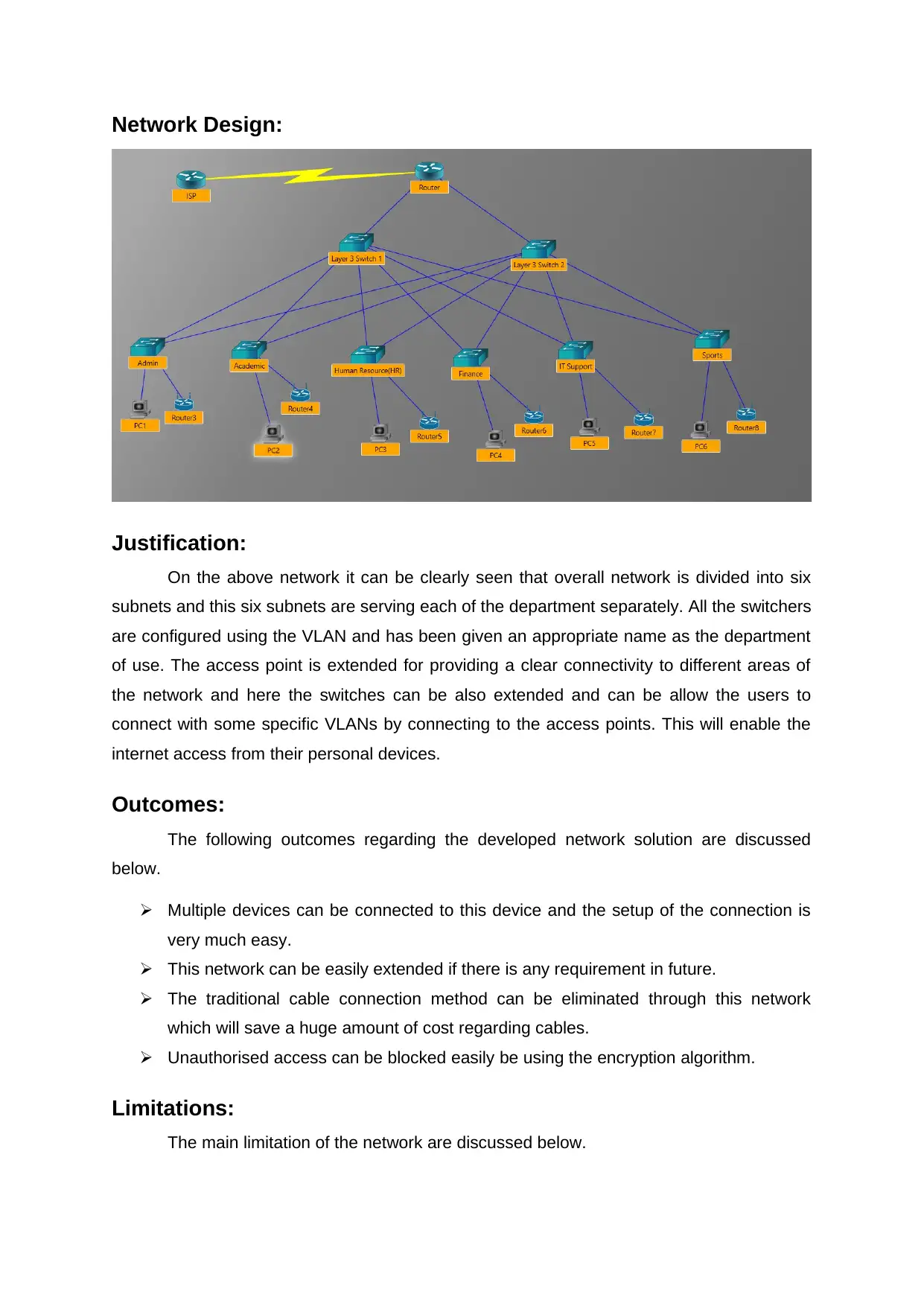
Network Design:
Justification:
On the above network it can be clearly seen that overall network is divided into six
subnets and this six subnets are serving each of the department separately. All the switchers
are configured using the VLAN and has been given an appropriate name as the department
of use. The access point is extended for providing a clear connectivity to different areas of
the network and here the switches can be also extended and can be allow the users to
connect with some specific VLANs by connecting to the access points. This will enable the
internet access from their personal devices.
Outcomes:
The following outcomes regarding the developed network solution are discussed
below.
Multiple devices can be connected to this device and the setup of the connection is
very much easy.
This network can be easily extended if there is any requirement in future.
The traditional cable connection method can be eliminated through this network
which will save a huge amount of cost regarding cables.
Unauthorised access can be blocked easily be using the encryption algorithm.
Limitations:
The main limitation of the network are discussed below.
Justification:
On the above network it can be clearly seen that overall network is divided into six
subnets and this six subnets are serving each of the department separately. All the switchers
are configured using the VLAN and has been given an appropriate name as the department
of use. The access point is extended for providing a clear connectivity to different areas of
the network and here the switches can be also extended and can be allow the users to
connect with some specific VLANs by connecting to the access points. This will enable the
internet access from their personal devices.
Outcomes:
The following outcomes regarding the developed network solution are discussed
below.
Multiple devices can be connected to this device and the setup of the connection is
very much easy.
This network can be easily extended if there is any requirement in future.
The traditional cable connection method can be eliminated through this network
which will save a huge amount of cost regarding cables.
Unauthorised access can be blocked easily be using the encryption algorithm.
Limitations:
The main limitation of the network are discussed below.
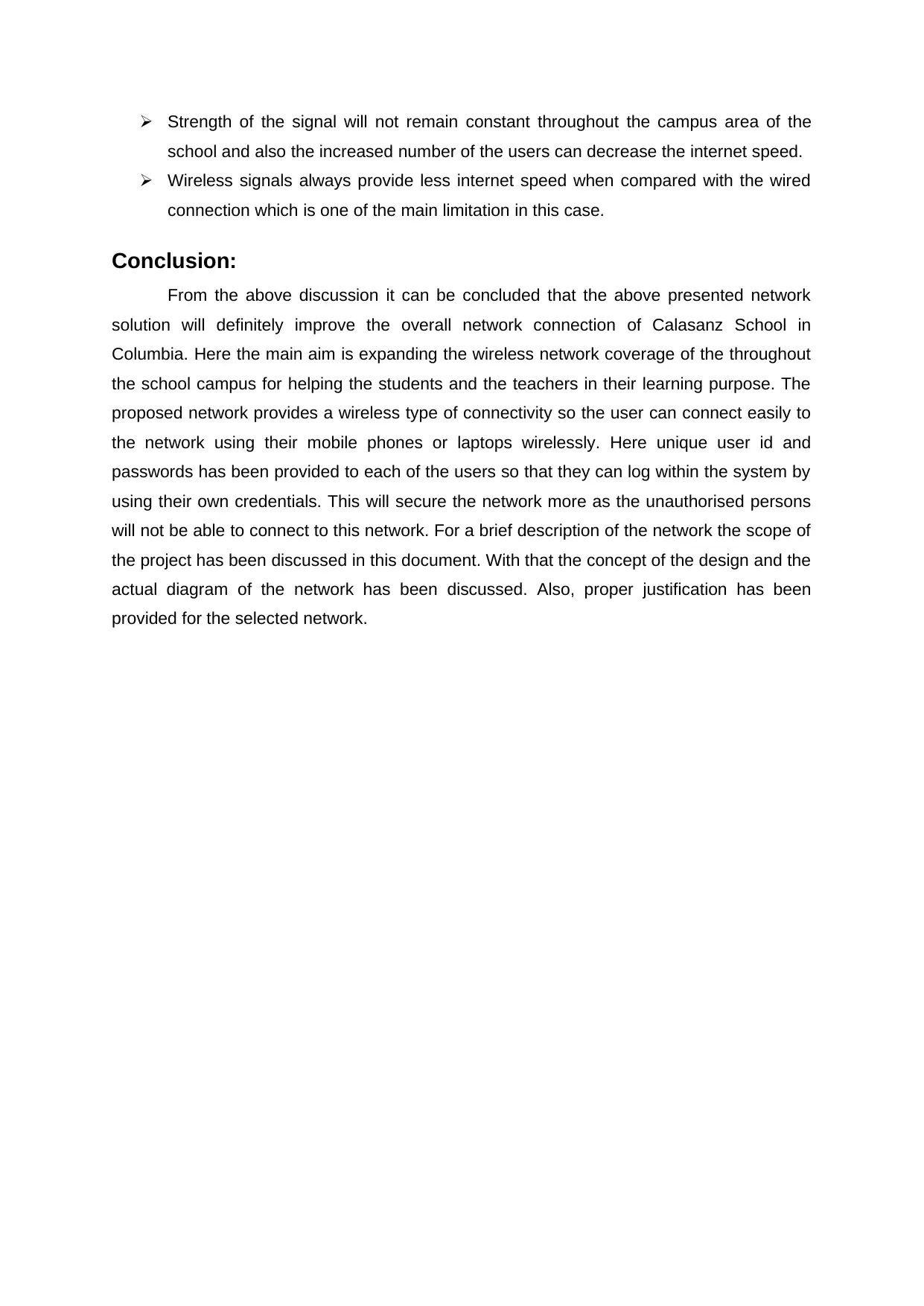
Strength of the signal will not remain constant throughout the campus area of the
school and also the increased number of the users can decrease the internet speed.
Wireless signals always provide less internet speed when compared with the wired
connection which is one of the main limitation in this case.
Conclusion:
From the above discussion it can be concluded that the above presented network
solution will definitely improve the overall network connection of Calasanz School in
Columbia. Here the main aim is expanding the wireless network coverage of the throughout
the school campus for helping the students and the teachers in their learning purpose. The
proposed network provides a wireless type of connectivity so the user can connect easily to
the network using their mobile phones or laptops wirelessly. Here unique user id and
passwords has been provided to each of the users so that they can log within the system by
using their own credentials. This will secure the network more as the unauthorised persons
will not be able to connect to this network. For a brief description of the network the scope of
the project has been discussed in this document. With that the concept of the design and the
actual diagram of the network has been discussed. Also, proper justification has been
provided for the selected network.
school and also the increased number of the users can decrease the internet speed.
Wireless signals always provide less internet speed when compared with the wired
connection which is one of the main limitation in this case.
Conclusion:
From the above discussion it can be concluded that the above presented network
solution will definitely improve the overall network connection of Calasanz School in
Columbia. Here the main aim is expanding the wireless network coverage of the throughout
the school campus for helping the students and the teachers in their learning purpose. The
proposed network provides a wireless type of connectivity so the user can connect easily to
the network using their mobile phones or laptops wirelessly. Here unique user id and
passwords has been provided to each of the users so that they can log within the system by
using their own credentials. This will secure the network more as the unauthorised persons
will not be able to connect to this network. For a brief description of the network the scope of
the project has been discussed in this document. With that the concept of the design and the
actual diagram of the network has been discussed. Also, proper justification has been
provided for the selected network.
Paraphrase This Document
Need a fresh take? Get an instant paraphrase of this document with our AI Paraphraser
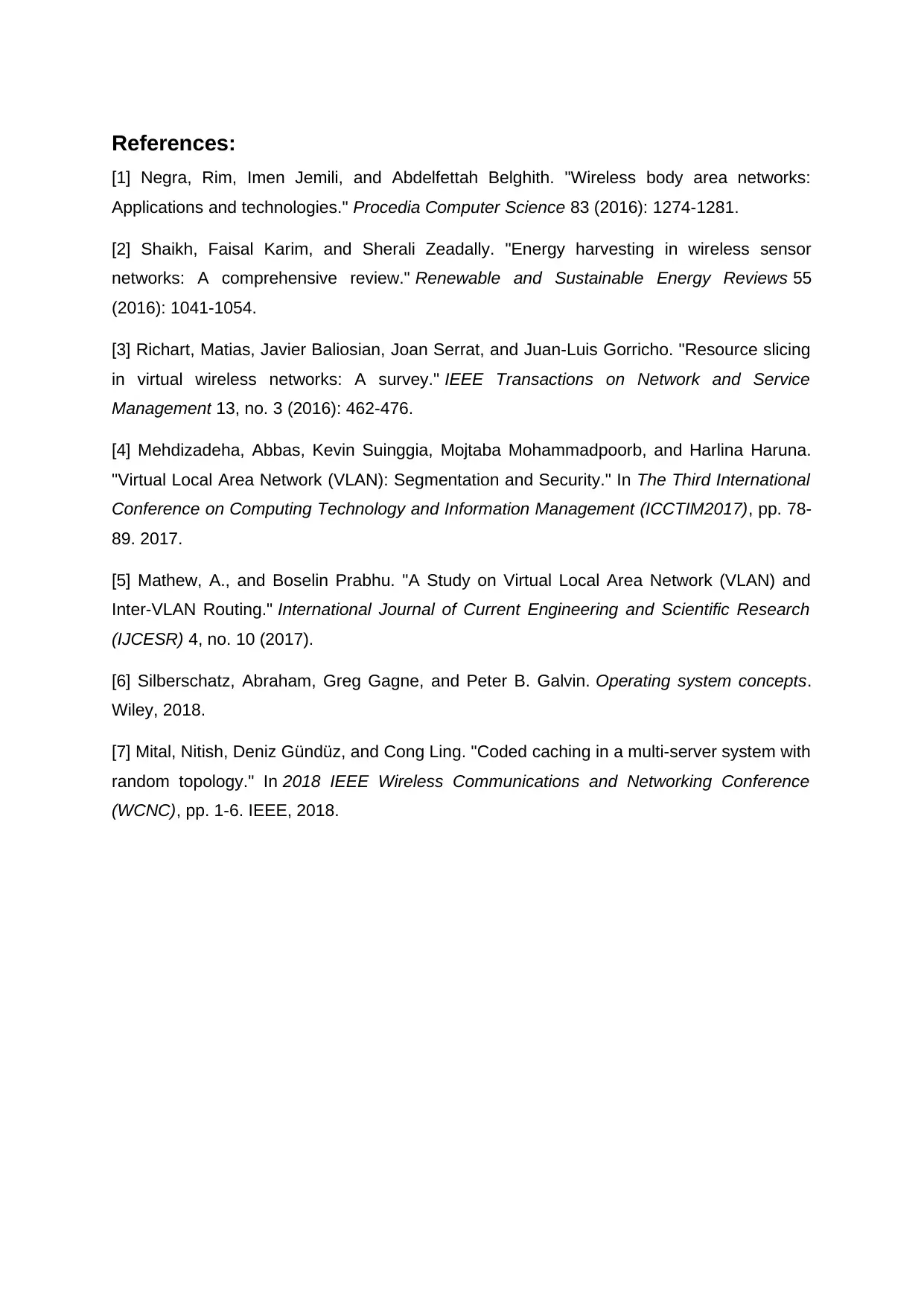
References:
[1] Negra, Rim, Imen Jemili, and Abdelfettah Belghith. "Wireless body area networks:
Applications and technologies." Procedia Computer Science 83 (2016): 1274-1281.
[2] Shaikh, Faisal Karim, and Sherali Zeadally. "Energy harvesting in wireless sensor
networks: A comprehensive review." Renewable and Sustainable Energy Reviews 55
(2016): 1041-1054.
[3] Richart, Matias, Javier Baliosian, Joan Serrat, and Juan-Luis Gorricho. "Resource slicing
in virtual wireless networks: A survey." IEEE Transactions on Network and Service
Management 13, no. 3 (2016): 462-476.
[4] Mehdizadeha, Abbas, Kevin Suinggia, Mojtaba Mohammadpoorb, and Harlina Haruna.
"Virtual Local Area Network (VLAN): Segmentation and Security." In The Third International
Conference on Computing Technology and Information Management (ICCTIM2017), pp. 78-
89. 2017.
[5] Mathew, A., and Boselin Prabhu. "A Study on Virtual Local Area Network (VLAN) and
Inter-VLAN Routing." International Journal of Current Engineering and Scientific Research
(IJCESR) 4, no. 10 (2017).
[6] Silberschatz, Abraham, Greg Gagne, and Peter B. Galvin. Operating system concepts.
Wiley, 2018.
[7] Mital, Nitish, Deniz Gündüz, and Cong Ling. "Coded caching in a multi-server system with
random topology." In 2018 IEEE Wireless Communications and Networking Conference
(WCNC), pp. 1-6. IEEE, 2018.
[1] Negra, Rim, Imen Jemili, and Abdelfettah Belghith. "Wireless body area networks:
Applications and technologies." Procedia Computer Science 83 (2016): 1274-1281.
[2] Shaikh, Faisal Karim, and Sherali Zeadally. "Energy harvesting in wireless sensor
networks: A comprehensive review." Renewable and Sustainable Energy Reviews 55
(2016): 1041-1054.
[3] Richart, Matias, Javier Baliosian, Joan Serrat, and Juan-Luis Gorricho. "Resource slicing
in virtual wireless networks: A survey." IEEE Transactions on Network and Service
Management 13, no. 3 (2016): 462-476.
[4] Mehdizadeha, Abbas, Kevin Suinggia, Mojtaba Mohammadpoorb, and Harlina Haruna.
"Virtual Local Area Network (VLAN): Segmentation and Security." In The Third International
Conference on Computing Technology and Information Management (ICCTIM2017), pp. 78-
89. 2017.
[5] Mathew, A., and Boselin Prabhu. "A Study on Virtual Local Area Network (VLAN) and
Inter-VLAN Routing." International Journal of Current Engineering and Scientific Research
(IJCESR) 4, no. 10 (2017).
[6] Silberschatz, Abraham, Greg Gagne, and Peter B. Galvin. Operating system concepts.
Wiley, 2018.
[7] Mital, Nitish, Deniz Gündüz, and Cong Ling. "Coded caching in a multi-server system with
random topology." In 2018 IEEE Wireless Communications and Networking Conference
(WCNC), pp. 1-6. IEEE, 2018.
1 out of 8
Related Documents
Your All-in-One AI-Powered Toolkit for Academic Success.
+13062052269
info@desklib.com
Available 24*7 on WhatsApp / Email
![[object Object]](/_next/static/media/star-bottom.7253800d.svg)
Unlock your academic potential
© 2024 | Zucol Services PVT LTD | All rights reserved.



